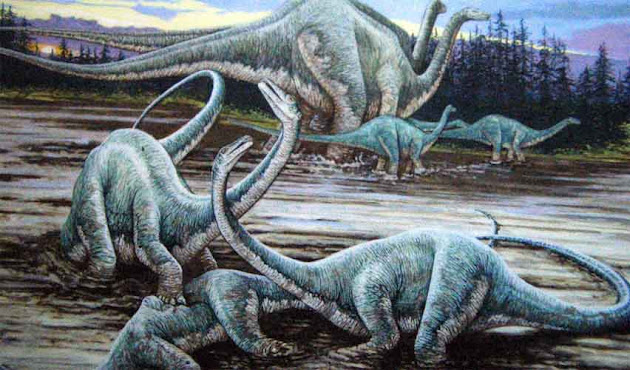Dinosaurs became extinct at the end of the Cretaceous Period. Experts are still confused about what caused their extinction. Some believe the extinction was caused by such as a meteorite or comet hitting the earth and others believe more gradual processes should be responsible, such as competition between mammals and dinosaurs, or severe climate change. We're also not sure how long it took for the extinction to occur. Some believe it happened over half a million years and others say it only took a few days. The extinction event that killed the dinosaurs affected the whole earth! Plants and animals on land and water were affected. The loss of other living things was so great that scientists knew about the extinction 30 years before the first dinosaur was discovered.
Victims of the Cretaceous extinction included dinosaurs, ammonites (mollusks related to octopuses, and chambered nautiluses), pterosaurs, and certain groups of plants. But many other animal groups, such as mammals, turtles, crocodiles, salamanders, toads, birds, snails, bivalves, starfish, and sea urchins. Even some groups of large-bodied reptiles, such as Champsosaurs, were not affected. The idea that the dinosaurs have passed and left the world of shrew-like mammals and cold-blooded reptiles is wrong. On the contrary, many modern land animals have taken up residence in the Cretaceous.
Dinosaurs shared with modern creatures in the last millions of years. Because more than just dinosaurs went extinct, reasons that only explain why dinosaurs died out can be ruled out. For example, there is one theory that disease caused the extinction of dinosaurs. But disease could not have caused the extinction of plants and animals all over the world. There are two groups of extinction theories: catastrophic extinction and gradual extinction. Catastrophic extinctions would be caused by a sudden external event, such as the earth colliding with an asteroid, or the eruption of a series of giant volcanoes. Gradual extinctions would be the result of changes in land mass and climate shifts. It could also be because new and improved animals won in the struggle for existence.
The space asteroid collision theory stems from the discovery of layers of rock dated precisely to the extinction event, and rich in the metal iridium. These layers are found all over the world, on land, and in the oceans. Iridium is rarely found on Earth but is found in meteorites at similar concentrations as in these layers. This has led scientists to postulate that iridium was scattered around the world when a comet or asteroid struck somewhere on Earth and then vaporized. The 110-mile (180-kilometer) crater carved into Mexico's Yucatán Peninsula, named Chicxulub, dates back 65 million years. Many scientists believe this crater occurred during the extinction of the dinosaurs.
But the Earth's core is also rich in iridium, and the core is the source of magma that some scientists say spewed out like a flood current piling up more than 1.5 miles (2.4 kilometers) thick over 1 million square miles (2.6 million square kilometers) of India. This volcanic upheaval also dates back about 65 million years and spread iridium around the world, along with sunburning dust and soot, and greenhouse gases.
Until the recent theory of the crash, some ideas about the disappearance of dinosaurs focused on mammals beating them in the fight for survival. One theory suggests that mammals killed dinosaurs because they ate dinosaur eggs. Other scientists say that dinosaurs caused their own extinction. According to this theory, too many meat-eating dinosaurs evolved, eating all the plant-eaters, causing all the dinosaurs to die out. This idea has the same pitfalls as before. They explain the extinction of dinosaurs but ignore the extinction of other groups. Extinction events did not kill off all animal and plant life. Many kinds of animals survived, including fish, frogs, turtles, crocodiles, birds, and mammals. Scientists must take the fossil record and find the reasons for all extinctions.
Read also 15 Mysterious Antique Ruin In The World
